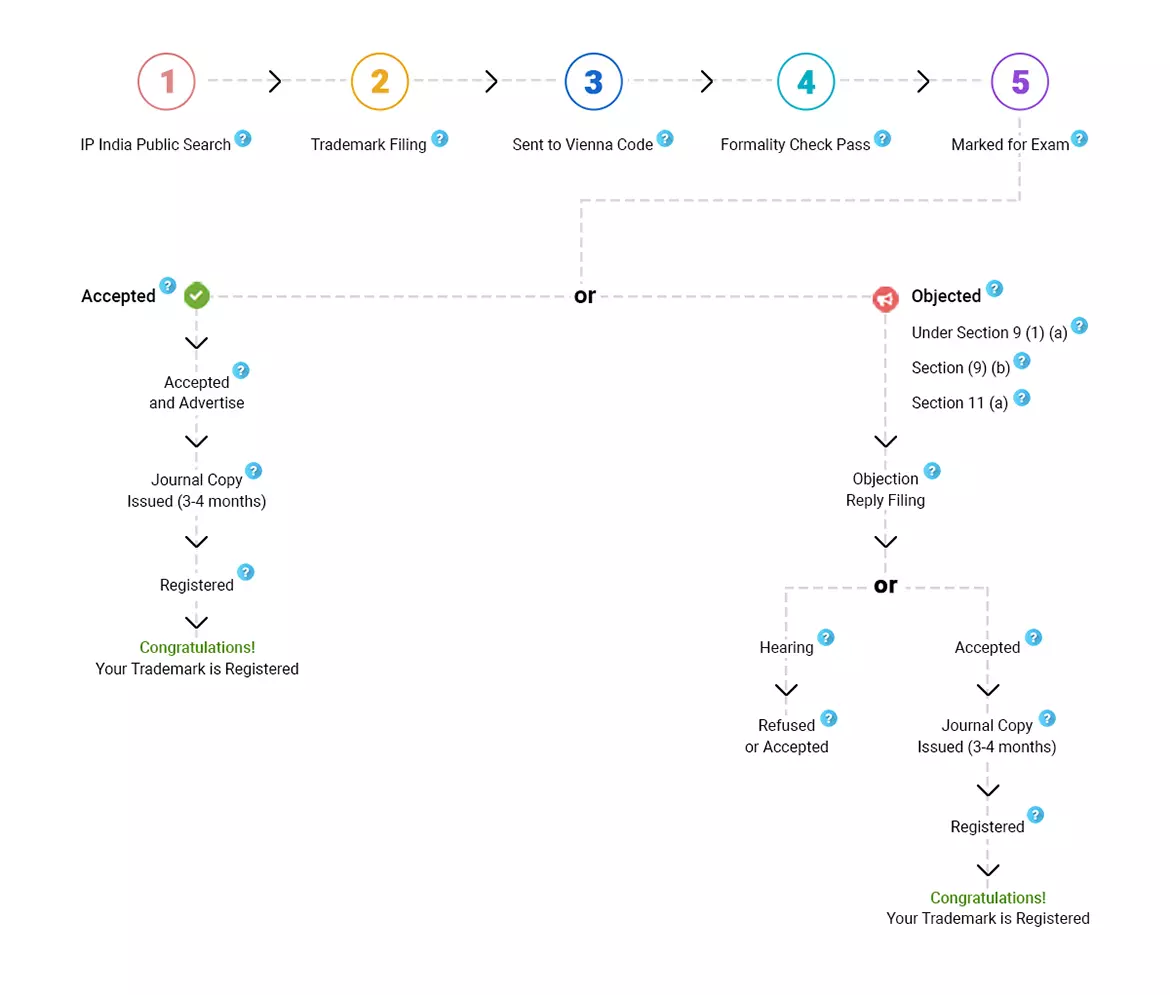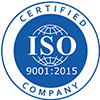


Trademark Registration gives the owner an exclusive right to protect the Logo, Symbol, and Words as the identity of the Brand. To Protect your brand with our trademark registration services.
TM
SM
R
C
When there is a TM on the brand name or logo, it indicates that the trademark application has been filed and the registration is under process. An applicant can use the TM beside his brand name or logo once the application is filed. He can use it until the registration is done. After completion of registration, the TM gets replaced by ® which means the trademark registration is completed and it is valid for 10 years.






For trademark registration, you need to pay Rs. 9000/- as Government fees. But if you own a MSME/SSI/Udyog Aadhar certificate, this Government fee is reduced to 50%.
A trademark is any mark, logo, name, symbol, letter, figure, or word used by any individual or firm to uniquely identify its goods or services from those made or sold by others. As a result, clients must be able to differentiate one's goods or services from those of others. The requirements of the Trade Marks Act 1999 regulate trademark registration. Trademark registration is vital because the government legally authorises it to grant the owner exclusive rights to the brand, sale, manufacture, and use of products and services.
In India, anybody who claims to be the trademark owner, whether an individual, proprietor, corporation or other legal organisation, can apply for a trademark. The trademark application can be filed, and the "TM" sign can be used within a few days post registration following registration. The Trade Mark Registry takes a minimum 6-8 months to register if there's no objection raised by the Registry. In case of an objection, it might take up to 18 months. After the trademark is registered and the registration certificate is issued, the registered symbol i.e. R, can be used. Once a trademark registration is done, it will be valid for ten years from the registration date and has to be renewed at the due time.
An individual person who is not currently in business can also file a trademark application and receive trademark registration for the brand name/device) that the applicant intends to use in the future.
A Firm’s joint proprietors can apply for a trademark together, and both of their names may be listed in the application.
When registering a trademark, a partnership business with a maximum of 10 members must include all partners' names in the application. In addition, if a minor partner is present, the name of the minor's guardian must be stated.
The application for the Limited Liability Partnership should be in the name of the LLP. It is a legal entity in which each participant has their own identity. Because the trademark belongs to the LLP, the partners cannot be applicants. The application must contain all the partners' names.
Any Indian firm, whether private limited, public limited, or any other type, must file a trademark application in its name. Because every incorporated organisation has its own legal body and identity, the director of a company cannot be a trademark applicant.
If a foreign-incorporated firm files for a trademark in India, it must do so under the corporate name as it is registered in the foreign nation. The registration type, the government, and the law should all be indicated here. It must mention the Indian address from which they are running their business in INDIA.
When filing a trademark application on behalf of a trust or society, the managing trustee, chairman, or secretary of the trust or society must be mentioned.
The following are the kinds of trademark registration available in India-
A service mark is comparable to a product mark representing a service rather than a product. The primary function of a service mark is to differentiate its proprietors from the owners of other benefits. Accordingly, trademark applications submitted under trademark classes 35-45 may be classified as service marks since they represent a service.
These are the marks that have been registered for usage before or after a chain of items that share a similar suffix, prefix, or symbol.
A sound mark is a sound that may be connected to a product or service that originates from a certain provider. Sound logos, often known as audio mnemonics, appear at the beginning and end of ads.
The importance of trademark registration in India is as follows:
The registered trademark owner has complete control over it. The owner may use the same trademark for all other items that fall within the designated class(es) in the application. Furthermore, the proprietor owns the trademark and can prohibit others from using it in the class(es) in which it is registered. It also gives the owner the ability to sue for any unauthorised violation.
Trademarks signify a product's or service's reputation and quality. Registering a trademark increases client confidence and recognition in the market. Furthermore, it contributes to the establishment of loyal and long-term customers who will continually choose your trademarked brand over others.
Customers can quickly locate your items if you register your trademark. It separates your goods or service from the competition while acting as an efficient advertising tool. Furthermore, your trademark or logo communicates your organisation's vision, quality, and uniqueness.
Trademark registration provides physical confirmation of the value and quality of your product or service. As a result, customers identify the quality of a service or product with the trademark. Moreover, this awareness benefits acquiring new clients who unwittingly identify a product or service's quality through its logo.
The registration of a trademark grants a corporation intellectual property. A registered trademark is a legal right that may be purchased, assigned, franchised, or economically contracted. Furthermore, a trademark functions as an intangible asset on a company's financial sheet, providing all of the benefits associated with such assets.
When your trademark is registered, you may use the ® sign in your logo to show that it is a registered trademark & that no one else may use a similar brand. If another individual uses your trademark without your permission, you can sue in court for such obvious infringement of your exclusive usage rights.
If someone uses a trademark without the owner's permission or in a deceptive manner, the owner can get an injunction to prevent the individual from using the brand without permission. In addition, your trademarked logo may not be used by anyone else, including rivals.
Trademark registration is inexpensive and helps your organisation to keep a distinct identity. In addition, online trademark registration is simple & inexpensive to keep up with. Similarly, when registering a trademark, you must pay the protection charge & the renewal price, which is due every ten years.
If you wish to grow outside of India or just register a trademark in another country, don't be concerned; a trademark that has previously been registered in India may serve as a strong basis for gaining worldwide recognition. Furthermore, because of all the goodwill accumulated, a trademark that has previously been registered in India can be utilised as the foundation for registration in another nation.
Popular businesses have a reputation for recruiting young talent. Furthermore, young brains prefer to work for major firms since they provide better benefits and salary security. In addition, trademark registration provides a favourable image of a company. Furthermore, this reduces the cost of recruiting and other associated activities.
The trademark registry was founded in 1940, followed by the Trademark Act in 1999. Currently, the trademark registry serves as the Act's operational or functional body. It can also be stated to be functioning concurrently. As a functioning entity, the trademark registry administers all of the laws and regulations of the Indian trademark Act.
The trademark registry's headquarters are in Mumbai, with branch offices in Delhi, Ahmedabad, Chennai, and Kolkata. When registering a trademark, it is first registered under the Trademark Act of 1999, and then it is registered with the trademark registrar. Before registering a trade mark, the registrar will verify to see if it fits all of the Act's requirements.
There are 45 trademark classes, and all goods and services are classified according to these classes. You must exercise extreme caution while selecting the classes since they will affect the validity of your trademark for your company's products/services. If your company sells various goods and services that fall into several classes, you must guarantee that you may file for a trademark under all of the appropriate classes.
In India, some of the most common trademark classes are:
There are some steps involved in the plan of trademark registration-
The registered trademark owner has complete control over it. The owner may use the same trademark for all other items that fall within the designated class(es) in the application. Furthermore, the proprietor owns the trademark and can prohibit others from using it in the class(es) in which it is registered. It also gives the owner the ability to sue for any unauthorised violation.
Trademarks signify a product's or service's reputation and quality. Registering a trademark increases client confidence and recognition in the market. Furthermore, it contributes to the establishment of loyal and long-term customers who will continually choose your trademarked brand over others.
Remember to select a unique and distinct mark to represent your organisation. Another critical aspect is determining which class you belong to. There are now 45 kinds of products and services for which a trademark can be registered. Classifications 1–34 are for products, whereas classes 35–45 are for services.
Once you've decided on a mark, you should run a search to see if it's comparable to an already registered mark. You may do this yourself by visiting the Controller General's website for Patents, Designs, and Trademarks. A public search option is available on the website. After selecting this option, you must select your class and search the online database.
You can file a single application for several classes, series, or collective trademarks. Form TM-A must be completed for this. This form allows you to register your trademark in more than one class. This form has two distinct cost brackets:
The Vienna Categorisation, often known as the Vienna Codification, is an international classification of trademark sign components created by the Vienna Agreement (1973). Following the Trademark registration application filing, the Trademark Registrar will file the Vienna classification to the Trademark established on the marks' figurative components. Accordingly, the trademark application status is normally indicated as "Sent to Vienna Codification" while this work is being done.
The online procedure of trademark registration involves the following steps:
Choosing a different and offbeat brand name is a sensible choice because most generic names are already in the hands of someone. Furthermore, settling on a name necessitates a rapid research procedure to guarantee that you are not selecting a brand name that is already in use. The best thing is that you may develop a distinctive brand name by inventing or coining some phrases and combining them with generic terms.
The following supporting papers must be presented with the application for online trademark registration:
The two methods for filing the registration application are manual filing and e-filing (form TM-A). If you select manual filing, you must personally transport and hand over your application for registration to the Registrar Office of TradeMarks in major Indian cities such as Delhi, Mumbai, Kolkata, Ahmedabad, and Chennai. Following that, you must wait at least 15 -20 days to receive the acknowledgement. In the event of an e-filing system, however, you will immediately obtain your receipt of acknowledgement on the government website.
Once the application is submitted, the Registrar of Trademarks will review it to see if you fulfilled specific requirements and if your brand name fits with current legislation. Furthermore, there must be no similarity (visual or phonetical) of identity with any existing brand which is pending for registration.
Following the examination procedure, if there is no objection raised by the registry (the stipulated time period may vary), the Registrar of Trademarks will accept and publish the brand name in the Indian trademark journal. This is perhaps the most crucial aspect of trademark registration. Within 4 months from the date of publication in the journal, any third party can oppose the instant application if there are any similarities between their brand name and the brand name in question. If within that time period no opposition is filed, the Registrar of Trademarks will issue the Trademark Registration Certificate.
Suppose a third party files an objection within four (time period may vary) months of the trademark's publication in the trademarks journal. In that case, the Registrar of Trademarks will provide you with a copy of the opposition notice. You must respond to the opposition notice within 2 months by filing a counter-statement. If the counter statement is not submitted within two months, the trademark application will be regarded as abandoned and refused. In case of both the Notice of opposition and Counter statement the government fee of Rs. 2700 is to be paid by both the parties while filing.
However, suppose no objection is filed within three months. In that case, this procedure will not apply to you, and your brand name will be accepted for issuing a Trademark Registration Certificate.
This procedure does not apply to you if there is no such trademark opposition in your case.
Suppose a third party contests your trademark, and you respond within two months. In that case, the Registrar of Trademarks will send a receipt of your response to the third party opposing trademark registration.
You and the third party must produce evidence in support of your claims. Following the filing of evidence under Rule 45, the Registrar will hold a hearing for you and the third party. You may submit your evidence under rule 46 or a notice intimating the registry that you will be relying upon the counter statement which has already been filed by you. The Registrar will issue an order accepting or rejecting the trademark application after hearing both parties and examining the facts. If the Registrar of Trademarks accepts your trademark application, he will proceed with the registration procedure.
The Registrar will approve your trademark application if there's no objection being raised within the time period which may vary or on acceptance of your trademark application following a trademark opposition hearing. Wow! And the best moment for you would be when the Registrar issues the Registration Certificate with the Trademark Registry stamp. You can use the registered trademark sign (®) beside your brand name as soon as you get your certificate.





A trademark is a distinct identity that distinguishes your organisation, product, or service from the competition. A registered trademark is the intellectual property/intangible asset of your company. It safeguards your investment in building client trust and loyalty.
Registration of a trademark gives you the ability to sue anybody who attempts to replicate your trademark and prohibits others from using an identical trademark to the one you registered.
 Trustpilot
Trustpilot

Aim from Mumbai and work with a Kolkata Company. Earlier I was little hesitating how thinks would turn around but soon I got my results and faith. I personally recommend you all to work with Adv Ms. Sarkar. She has done my company’s Copyright and Trademark Registration. Thank you.

We got our brand trademark registration done with OnlineLegalIndia. The team was very professional and the processing experience was remarkable. Special thanks to Bulti the advocate who handled the application.

Flawless filing of trade mark.We really appreciate the gesture of online legal india staff especially mam Advocate Stakshi Ganguly.

Easy and simple way to get legal work done.

Thank you online legal India & Adv. for support in getting trade mark Registration faster. We found Adv. Very sincere and efficient in her work we wish her all the best for a very bright future.

Thank you online legal India & Adv. for support in getting trade mark faster

Had a good experience with FSSAI & TRADEMARK application. AMRIT FOR FSSAI-

I tried OnlineLegalIndia for the first time for Trademark Registration for my firm. I found their team quite efficient. As soon as the payment was made, Adv Satarupa Sarkar was assigned to the task. Customer service kept me posted on progress. Satarupa asked for few inputs and made the entire process hassle free. Overall a very cost effective and efficient service.

trademark application filed successfully. thankyou adv. Of Online Legal India

I am very much satisfied by the quality service provided by the online legal India regarding the registration of trademark. I especially thanks mam for Handling and Drafting of cases in a beautiful manner. I am happy and I hope I will be the happiest customer when I will get my Trademark Registered.











 1999
1999  4999
4999  11999
11999  14999
14999  3999
3999  1999
1999  4999
4999  11999
11999  14999
14999  3999
3999 
Founder of Online Legal India





Past Experiences



‘Kahin par pohochne ke liye, kahin se nikalna bohot zaroori hota hai’
- Yeh Jawani Hain Deewani
- Rajesh Kewat

The registration of Trademark gives you the exclusive right to use of the registered trademark and indicate so by using next to your brand name

In case you doubt that your trademark is being copied by anyone else, you can take up the issue legally and sue them if you have registered your logo, brand name or slogan.

Registering a trademark ensures that competitors will not use it and hence the customers will not get confused.

Registered trademark is a right created which can be sold, assigned, franchised or commercially contracted.

For any person willing to expand outside India, the trademark registered in India can provide a good base along with the Established goodwill in the Country.

It helps in creating permanent customers who are loyal and always opt for the same brand.
How TM Expert Will Process Your Trademark Registration


Fill our Registrat ion Form & Make the Payment
⟶
We will search the class of your brand by trademark expert
⟶
We will draft the authorizattion letter (Form-48)
⟶
Upload the Required Documents
⟶
Our expert will file the TM Application
⟶
Congratulations! You can use now TM next to your Brand
👍

Recognized by Govt. of India

1 Lakh+ Happy Clients Across India

ISO Certified

Data Security & Trust

Trained & Professional Experts

On Time Service

Super Fast Service

Quick Response Team

Affordable Than Other Professionals







Trademark is an intellectual property consisting of recognizable sign or design in order to identify products or services from a specific source, although trademarks that are used to identify services are called service marks.